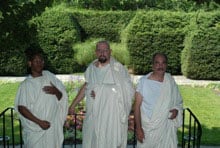La Associazione Tradizionale Pietas is a cultural organization without political interests. It holds diverse historical and cultural interests related to ancient Rome. Some members are practitioners of Roman rituals along the same line as MTR while others may be cultores Deorum Romani.
Different from both of the above, L'associazione religiosa Gentilitas - Spiritualità Italica is both a religious and philosophical organization of cultores Deorum Romani. Founded in 2006, this association is organized into small communities of cultores Deorum and Gentiles Romani where each has a Minister of Worship (ministre di culto) who works in partnership with individuals as an instructor on the practice of the Religio Romana, philosophy, ethics, and spirituality. A Spiritual Council of Ministers appoints new ministers based on their knowledge, skills, and dignity among a community of worshippers. As its name suggests, the focus of the Gentilitas is with the family cultus for the Lares and patron deities. The Gentilitas rejects the idea of the Religio Romana as a state religion, and therefore is not a political organization, and it rejects any form of hierarchal priestly orders, preferring to keep its focus on individual worship and development of an individual's spirituality among living communities of the Religio Romana.
Developments of the Religio Romana in Italy have been mirrored in the United States, and carried from there to other parts of the world. Interest in reviving the Religio Romana in the U.S. began with the Julian Society founded by William Bradford (M. Cassius Julianus), who went on to co-found Nova Roma in 1998. Wm. Bradford and his friend Bloch were inspired by the MTR when they first founded Nova Roma. However, they left membership open to any and all who were interested in ancient Rome, and thus over the course of its first ten years it developed into something like La Associazione Tradizionale Pietas.
Nova Roma has cultores Deorum whose interests are found in the spiritual and religious tradition of the Religio Romana, as well as in philosophy and the Roman virtues related to ethics. Nova Roma also has "reconstructionists" and "practitioners" whose interest is the performance of reconstructed rituals, but not necessarily in the spiritual or metaphysical aspect of the tradition. And Nova Roma has an assortment of "non-practitioners" who follow Jewish, Christian, Hindu, Muslim, and other traditions, or no traditions at all, as well as a variety of polytheists, neopagans, and others.
 Tensions in Nova Roma over political issues and over religious issues have led to break-away organizations. These included the cultural association known as the Societas Via Romana, and such religious organizations as the Pax Deorum of Ohio, formed by pontifices of Nova Roma (Left); the Temple Religio Romana of California founded by a former Pontifex of Nova Roma, Cornelia Antonia; and the Clarion Temple of the Religio Terranova. Italian members of Nova Roma, in reaction to Nova Roma, were also involved in founding the Religious Association of Gentilitas of Italy.
Tensions in Nova Roma over political issues and over religious issues have led to break-away organizations. These included the cultural association known as the Societas Via Romana, and such religious organizations as the Pax Deorum of Ohio, formed by pontifices of Nova Roma (Left); the Temple Religio Romana of California founded by a former Pontifex of Nova Roma, Cornelia Antonia; and the Clarion Temple of the Religio Terranova. Italian members of Nova Roma, in reaction to Nova Roma, were also involved in founding the Religious Association of Gentilitas of Italy.
Nova Roma has promoted the development of several local communities of cultores Deorum in North and South America, in Europe, Australia and Asia, sometimes within Nova Roma itself as we see with Eastern Europe and the U.S. today, and, unfortunately, often in reaction to Nova Roma by the formation of new organizations. Internal politics within Nova Roma has been a continuous problem since its first year. Another factor has been that Nova Roma is not an organization of the Religio Romana but only an organization that provides for an international community of practitioners and cultores Deorum to meet one another. Both problems have resulted from Nova Roma being essentially an internet community, when what cultores Deorum seek are local communities of fellow worshippers of the Gods actively working together as the Gentilitas has managed to create in Italy.
On the positive side, Nova Roma has steadily improved on the information it collects about the Religio Romana and its traditions, and therefore improved on the quality of scholarship in the information it disseminates about the Religio Romana for all cultores Deorum to access. The Societas Via Romana, Gentilitas and other organizations have likewise improved the knowledge of the general public about the Religio Romana, attracting more practitioners and cultores Deorum into the tradition. In the past two years, Nova Roma has also developed its own modern rituals, based closely on historical examples, and thus provides a standard model of ritual practice for cultores Deorum Romani both within and outside Nova Roma. As a source of information on the internet, Nova Roma, Gentilitas, the Societas Via Romana, and similar organizations have fueled greater interest in the Religio Romana as a post-modern religious tradition. In addition, such organizations have brought together cultores Deorum from different parts of the world in face-to-face conferences and established bonds of cooperation. But these have been internal conferences, with few exceptions, leaving different organizations of the Religio Romana isolated from one another even when some individuals are members of more than one organization.




